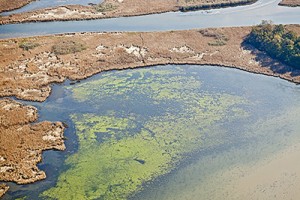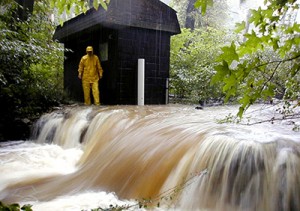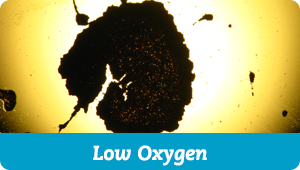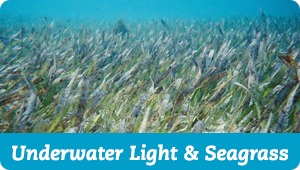Nutrients foster growth and life. Plants depend on nutrients in the soil—especially nitrates and phosphates—to grow roots, produce fruit and build the chlorophyll they need for photosynthesis. But when their levels climb to high, these same nutrients can also bring death.

Phytoplankton bloom. Massive outpourings of nutrients from land feed algae in the Bay, creating dangerous blooms that keep light and oxygen from organisms underneath. © Chuck Gallegos and LightHawk.
Danger comes in the form of harmful algal blooms. When too many nutrients from the land stream into bays and estuaries, microscopic algae called phytoplankton feast on the nutrient surplus and go through a massive growth spurt. The newly-formed algal blooms coat the water in green, red or brown slime that blocks light to plants underneath. Underwater seagrasses, unable to photosynthesize, die off for lack of sunlight. Fish and crustaceans that depend on seagrasses for food or shelter are forced to search elsewhere. Algal blooms also drain the water’s oxygen supply. When phytoplankton die and sink to the seafloor, the bacteria that decompose them suck dissolved oxygen out of the water. The low-oxygen or “dead zones” they create can last for months or years.
But nutrients can take many different paths. Not all of them end in harm. In this video, ecologist Tom Jordan tracks the various journeys nutrients make to reach open water.

Ecologist Tom Jordan surveying one of SERC’s weirs when it overflowed during Hurricane Floyd in 1999.
Some nitrogen starts in the atmosphere from cars and power plants and falls to the ground as rain. The entire stretch of air that can pour nutrients into the Bay is called an airshed. The Chesapeake’s airshed is enormous: 570,000 square miles stretching from Canada, Ohio and South Carolina. Other nutrients begin in the watershed: the area of land that drains into a body of water. The Chesapeake watershed encompasses land in Maryland, Delaware, Virginia, West Virginia, New York, Pennsylvania and the District of Columbia. Here, nitrogen and phosphorus wash out of fertilizer from farms, or sewage from cities and suburbs. Streams then carry the nutrients to rivers, and rivers carry them to the sea—unless something stops them.

Weirs measure the flow of water in a stream. Some, like this one, can automatically collect water samples for scientists to analyze in lab.
Streamside forests, or riparian buffers, can filter nutrients out of the water and trap them in the soil. Coastal wetlands have the same purifying power. If nutrient-polluted water passes through a forest or marsh before reaching the shore, the nutrients will remain in the ground, nourishing life on land without endangering life in the water.
Learn more!
See how Tom Jordan and other ecologists are studying how to restore streams and clean up watersheds in the Nutrient Cycles Lab.

 Nearly one-third of the nitrogen load in Chesapeake waters comes from air pollution! Some of it comes from as far away as Canada or South Carolina. Brainstorm ways to save energy. Reducing your CO2 output can help the Bay as well.
Nearly one-third of the nitrogen load in Chesapeake waters comes from air pollution! Some of it comes from as far away as Canada or South Carolina. Brainstorm ways to save energy. Reducing your CO2 output can help the Bay as well.

